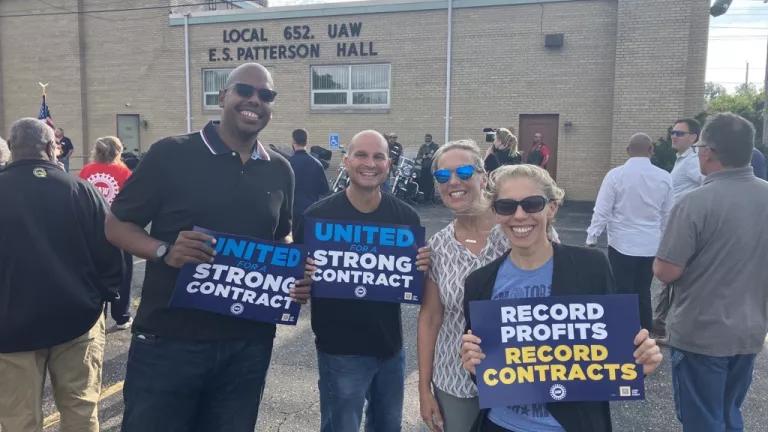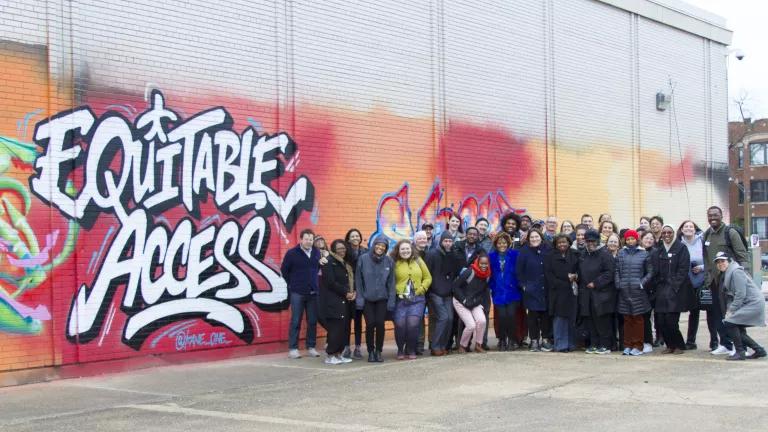EPA, Do the Right Thing on Truck Pollution
If the Biden administration is going to deliver on its pledges to address climate change and environmental justice, EPA must approve the most ambitious state and federal heavy-duty vehicle standards possible.

Source Raymond Clark Images
This is a joint blog with Atenas Mena, Co-Executive Director of CleanAirNow, an environmental justice non-profit based in Kansas City, Missouri.
This year, the Biden administration must fulfill its responsibility to reduce deadly air pollution from trucks, buses, and other heavy-duty vehicles. If the administration is going to deliver on its pledges to address climate change and environmental justice, the Environmental Protection Agency must approve the most ambitious state and federal heavy-duty vehicle standards possible. This means finalizing a national clean truck standard that slashes fossil fuel truck pollution while accelerating the transition to electric trucks and enabling states to take additional steps to tackle air pollution. Without these actions, harmful pollution could be locked in for decades to come.
EPA has a good template to follow. Led by California, states are cutting truck pollution by adopting new emission standards, including the Heavy-Duty Omnibus and Advanced Clean Trucks rules. To enforce these and other rules, EPA is reviewing three Clean Air Act waiver preemption requests. The waiver allows California—and any state that adopts California’s standards—to enforce these lifesaving regulations. That sets up another key opportunity for the agency: will it follow decades of precedent and stand with communities demanding change by granting these waivers in full? Or will the opposition from a handful of multinational engine makers lead to a decision that will only benefit polluter profits?
Trucks’ Outsized and Disproportionate Pollution Impacts
Heavy-duty vehicles, such as delivery vans, garbage trucks, and 18-wheelers, are prolific polluters; accounting for 10% of on-road vehicles, they are responsible for nearly 30% of transportation-related greenhouse gas emissions, 45% of on-road nitrogen oxides and 57% of particulate matter emissions. This truck tailpipe pollution contributes to asthma, bronchitis, cardiovascular diseases, and premature death. The following figure shows that medium- and heavy-duty vehicles create a disproportionately high share of the total pollution from on-road vehicles.

This pollution is endemic. A report by the American Lung Association found that almost half of all Americans live in communities with unhealthy levels of air pollution, of which heavy-duty vehicles are a major contributor. This is doubly true for communities near transportation and freight infrastructure, labeled “diesel death zones'' due to the high morbidity and mortality rates. Because of racist policies such as redlining, many of these communities tend to be low-income communities and communities of color that have disproportionately suffered from toxic air pollution for decades.
Cumulative impacts contribute to lower life expectancy, as experienced in Kansas City neighborhoods.
Kansas City’s Legacy of Environmental Racism
Nestled in America’s heartland, Kansas City's story is shared by many communities across the country. Placed at the meeting of the Kansas and Missouri rivers, it became a key location for trading posts, rail development, warehouses, and industrial development at the turn of the 19th century. Before the expansion of the railroads in Kansas City, most people of color resided in the West Bottoms. Many families relocated to the east of Troost avenue because it offered easy transportation and more affordable housing. Communities of the white upper class moved west of Troost because they were concerned property values would drop when families of color moved in. They did not want people of color moving over to the west side. Redlining was created by the Home Owners Loan Corporation, based on race to help real estate agents decide where to invest money. Redlining in Kansas City, Missouri, led to investments west of Troost instead of east.
Historically redline communities were also placed near polluting facilities. Many communities in Kansas City still deal with legacy contamination from industrial sites and inactive hazardous facilities that have released toxins into the air, water, and soil for over a century and whose effects persist today. Redlining allowed neighborhoods of color to deteriorate and become more susceptible to any nearby pollution, natural disaster, and climate change impacts. Kansas City is the 5th most economically and racially segregated city in the United States. Like many other low-income communities and communities of color, Kansas City suffers from the cumulative impacts of toxic pollution, environmental racism, and the consequences of climate change. Consequently, a failure by EPA to mandate emission reductions from the freight sector will come at a deadly price.

Kansas City Region Low Income Households and Toxic Release Sites Proximity
The map shows the Home Owners’ Loan Corporation grades of current Kansas City neighborhoods as assigned by our spatial recalculation. Ninety-five percent of active Toxics Release Inventory sites are in neighborhoods with a D, or “Hazardous” grade.
EPA’s Proposed Truck Rule Needs an Overhaul
EPA’s proposed Clean Trucks Rule to limit tailpipe pollution like particulate matter from trucks falls short of mandating the emission reductions necessary to address this climate crisis. Nor does the current proposal provide a sufficient market signal to spur investment in the manufacturing, supply chains, and charging infrastructure to support the transition to zero-emission vehicles.
EPA must prioritize zero-emission vehicles in environmental justice communities like Kansas City, and stop perpetuating environmental racism.
As we explained in our comments with the Moving Forward Network, EPA must improve the proposal by:
- Ensuring all new truck sales are zero-emission no later than 2035;
- Requiring heavy-duty fossil fuel engines maximize emission reductions; and
- Prioritizing zero emissions technologies and infrastructure in frontline communities.
All New Trucks Must be Zero-Emission Trucks by 2035
The Clean Air Act directs EPA to establish “technology-forcing” standards to clean up truck emissions. Yet EPA’s proposal fails to adequately consider the most effective pollution control technology available: zero-emission vehicles.
Zero-emission technologies, such as battery electric trucks and buses, are already commercially available and cost-effective compared to their fossil fuel counterparts.
EPA can accelerate the transition in two ways:
- Require an increasing minimum number of zero-emission trucks be sold until all new sales are zero-emission no later than 2035 (with earlier dates for easier-to-electrify vehicles); or
- Establish a fleetwide declining nitrogen oxide emission limit that reaches zero by 2035.
If EPA fails to pursue either strategy, the proposal’s zero-emission vehicle compliance crediting must be removed. This crediting unfairly rewards manufacturers for zero-emission vehicle sales due to actions taken regardless of federal regulation. The credits can then be used to allow them to sell more dirty fossil fuel trucks.
Maximize Fossil Fuel Engine Emission Reductions
Even when only looking at feasible fossil fuel technologies, EPA’s proposal falls well short of achieving the greatest emission reductions. In fact, the strongest Option in EPA’s proposed Criteria Pollutant Program (Option 1) contains glaring deficiencies, including the failure to align with the state-level truck standards seen in the Heavy-Duty Omnibus rule, weak emission limits, and false solutions such as natural gas through early crediting. Option 2 is even worse, as it underperforms on all public health, environmental, and economic metrics.
To meet the scale of the air pollution problem, the adopted rule should immediately harmonize with state regulatory efforts beginning in model year 2027.
Who Will EPA Prioritize: People or Polluters?

Source: Minneapolis Public Works
There are two truck pollution priorities before the EPA right now: the Clean Trucks Rule and Clean Air Act Waivers. And, as required by President Biden’s Executive Order on Clean Cars and Trucks, EPA must begin the next phase of standards to cut greenhouse gas emissions from trucks.
But as the agency nears finalization of its Clean Trucks Rule, it must ensure it is the most ambitious version possible. And EPA should reaffirm states' rights to fight air pollution by approving the Clean Air Act waivers before them to enforce strong state truck emission standards.
Although truck manufacturers acknowledge that the transition to cleaner trucks is underway, and their CEOs are quick to tout sustainability commitments, they remain the biggest impediment. This heel-dragging is embodied in a recent lawsuit—that has since been withdrawn—supported by Volvo, Daimler, and Navistar, among others, attempting to delay California’s Heavy-Duty Omnibus rule—a rule whose public health benefits are measured in the billions of dollars and thousands of lives saved.
Additionally, a recent report by Influence Map reviewed hundreds of lobbying documents and uncovered a coordinated campaign spanning multiple state and federal agencies by truck manufacturers to undermine clean vehicle standards while waging a public relations campaign touting investments in clean technologies. It's clear—unless compelled through strong vehicle standards, truck manufacturer won’t clean up their products.
Setting a robust national combustion standard and zero-emission sales target is critical to ensure manufacturers accelerate the transition to a zero-emission future. In the end, EPA must step up and put people over polluters’ profits to protect public health.



